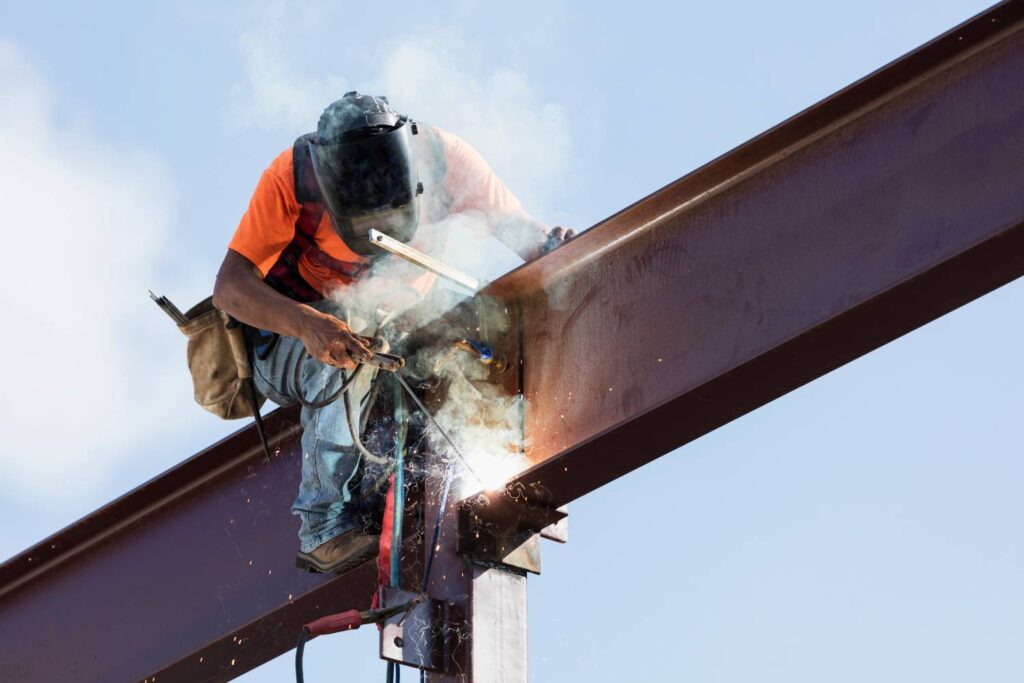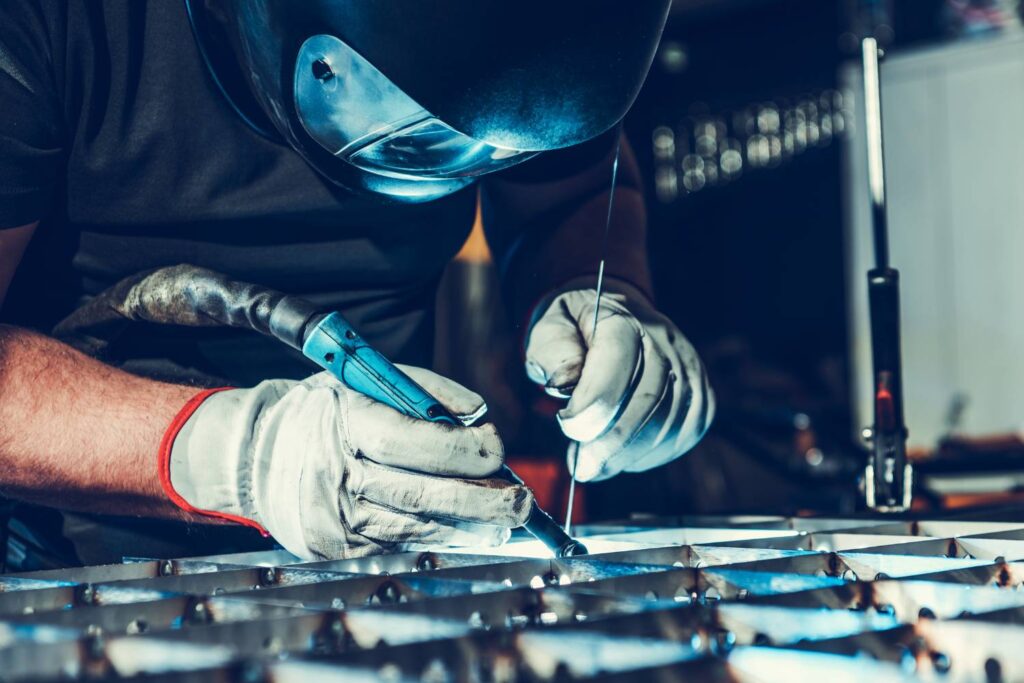"The Future of Welding" explores the transformative journey of welding practices, from ancient forges to modern automated processes. The blog explores the evolving welding landscape, where innovation meets tradition and technology expands the boundaries.
As we enter the 21st century, the welding industry faces challenges of digitalisation, automation, and sustainability. Advancements in welding technology, such as robotic welding and artificial intelligence, will impact the workforce, environment, and global economy. This blog offers insights into the future of welding.
Table of Contents
Technological Advancements In Welding
The realm of welding is undergoing a transformative phase, marked by significant technological advancements that promise to redefine the industry's future. From the ancient art of forge welding to the precision of arc welding, welding technology has been one of constant innovation and adaptation. Today, we stand at the brink of a new era where automation, digitalisation, and cutting-edge techniques are steering welding into uncharted territories.

The Evolution Of Welding Technology:
Welding technology has evolved from manual methods to sophisticated automated processes. Traditional techniques like gas, stick, MIG, and TIG welding have received technological updates, making them more efficient and versatile. Introducing state-of-the-art methods such as plasma welding, laser welding, electron beam welding, and friction-stir welding showcases the industry's commitment to innovation.
The Role Of Automation And Robotics:
Automation has revolutionised welding, enhancing productivity, accuracy, and safety. The advent of welding robots, particularly cobots (collaborative robots), signifies a shift towards more collaborative work environments where robots assist rather than replace human workers. These advancements allow quicker production, higher quality welds, and a safer working environment by minimising human exposure to hazardous conditions.
Digitalisation And Connectivity:
The digital transformation has helped the welding industry. Integrating the Internet of Things (IoT) and sensors in welding equipment enables real-time data collection and monitoring, paving the way for predictive maintenance, remote diagnostics, and proactive troubleshooting. This digital leap forward promises to streamline welding operations, enhance safety, and optimise productivity.
Sustainability And Green Welding Technologies:
The welding industry is embracing sustainability and green practices in response to growing environmental concerns. Innovations to reduce energy consumption, minimise waste, and utilise eco-friendly materials are gaining traction. Welding is pivotal in renewable energy projects, further underscoring its contribution to sustainable development.
Skills And Training For The Future:
As welding technology advances, so does the need for skilled professionals who can navigate these new landscapes. The future of welding demands a workforce that is not only technically proficient but also adaptable and continuously learning. Training programs and certifications are evolving to equip welders with the knowledge and skills to excel in this dynamic field.
Implications For The Welding Industry:
The advancements in welding technology bring about both opportunities and challenges. While automation, digitalisation, and green technologies promise improved efficiency and sustainability, they also necessitate significant investment and adaptation. The industry must navigate these changes thoughtfully, balancing innovation with practicality.
Embracing The Future:
The future of welding technology is bright and filled with potential for further advancements and innovations. By staying informed, embracing new technologies, and fostering a culture of continuous learning, the welding industry can look forward to a future where efficiency, quality, and sustainability are paramount.
Automation And Robotics In Welding
Technological Evolution And Adoption:
Welding automation employs robots to improve the production of welds, offering increased speed, precision, and consistency. The transition from manual to automated welding, facilitated by advancements in robotics, has led to the widespread adoption of robotic welding across various industries, including automotive, aerospace, and construction.
Diverse Welding Processes:
Robotic welding systems are versatile and capable of performing various welding processes such as arc welding, resistance welding, spot welding, TIG welding, and more. Each method offers unique advantages, from the high heat of arc welding for large-volume projects to the precision of TIG welding for tasks requiring meticulous attention to detail.
Advantages Of Robotic Welding:
The benefits of robotic welding are manifold. Automation ensures accuracy and less waste, contributing to faster operations and sustainability. Robots can adapt to various welding processes, providing flexibility in application. Moreover, using robots in welding enhances safety by reducing human exposure to hazardous conditions inherent in welding tasks.
Operational Efficiency And Safety:
Robotic welding increases productivity and significantly improves workplace safety. By automating the welding process, robots take on the physical risks associated with welding, such as exposure to intense heat and harmful fumes, safeguarding human workers. Additionally, the precision and repeatability offered by robots minimise errors and rework, further enhancing operational efficiency.
Future Prospects:
The future of robotic welding looks promising, with ongoing advancements to make welding processes more efficient, cost-effective, and accessible. Innovations in robotic welding, such as collaborative robots (cobots) designed to work alongside humans and the integration of artificial intelligence for more brilliant operation, are set to redefine the welding landscape. These developments promise to improve the quality and speed of welding tasks and open up new possibilities for customisation and complex projects.
Sustainability And Environmental Considerations
The welding industry is increasingly focusing on sustainability and environmental considerations. As the world becomes more conscious of the impact of industrial processes on the planet, welding practices are evolving to meet these challenges head-on. This shift is not just about adhering to new energy laws and eco-design directives but also about enhancing cost-effectiveness and minimising the environmental footprint of welding operations.
Resource-Conserving Processes:
Sustainable welding begins with the adoption of resource-conserving processes. Factors such as welding speed, system costs, raw materials, processing time, and filler metals play a crucial role in determining the sustainability of welding operations. A comprehensive view of the entire process chain, including the extraction of raw materials and the production of auxiliary materials, is essential for understanding and minimising the environmental impact.
Modern Welding Technology:
Modern and sophisticated welding technology is pivotal in achieving sustainable production. Advanced welding systems enable operators to increase welding speed while maintaining high quality, thereby reducing the consumption of energy and production resources. This approach enhances efficiency and contributes to the sustainability of welding practices.
Special Welding Processes:
Specific welding processes, such as MAG and laser gas metal arc welding, stand out for their sustainability. These methods are efficient, clean, fast, precise, and flexible, making them environmentally friendly for welding operations. However, the sustainability of welding is only partially dependent on the process used; it also involves considering the technical system effort against the consumption of resources, quality, and cost-effectiveness.
Sustainability In Welding Training:
Welder training is another area where sustainability can be integrated from the outset. Virtual Welding simulation systems, for example, allow novice welders to practice different welding processes without the need for consumables, thereby saving resources and costs. This type of training represents a significant step towards sustainable welding practices.
The Crucial Factors For Sustainable Welding:
Achieving sustainable welding requires a multifaceted approach. The proper welding process for the application, a higher welding speed, and a low rework and rejection rate are all critical for sustainable action in welding technology. The journey towards sustainable welding begins with selecting the right welding system that aligns with resource conservation and environmental protection goals.
The Future Workforce In Welding
The welding industry is pivotal, facing the dual challenges of environmental sustainability and a rapidly evolving workforce. As we delve into the future of welding, it's clear that the industry must adapt to embrace eco-friendly practices and prepare for a new generation of welders equipped with advanced technological skills.
Embracing Eco-Friendly Welding Techniques:
The environmental impact of traditional welding processes cannot be understated, with issues ranging from high energy consumption to releasing toxic emissions. The future of welding lies in adopting eco-friendly techniques that minimise waste and reduce energy usage.
Innovations such as friction stir welding, magnetic pulse welding, and laser arc hybrid welding offer greener alternatives, producing fewer emissions and requiring less energy. These advancements are crucial for sustainable construction and manufacturing practices.

Utilising Recyclable Materials And High-Quality Equipment:
A sustainable welding future also hinges on the efficient use of resources. Recycling used metal scraps and reusing materials are practices that significantly lower the environmental footprint of welding projects. Moreover, investing in high-quality welding equipment reduces waste and decreases energy consumption over time, contributing to environmental sustainability.
The Role Of Automation In Welding:
Automation is a transformative force in welding, promising enhanced efficiency, precision, and sustainability. Robotic welding systems, known for their consistency and minimal error, significantly reduce waste and material usage. Automation also implies a shift in the workforce, with a decreased need for manual labour on-site and reduced operational energy requirements. This shift supports sustainability goals and reshapes the skill sets required for future welders.
Training The Next Generation:
As welding processes become more technologically advanced and environmentally conscious, the industry faces a growing need for skilled professionals who can navigate these new landscapes. The future welding workforce must blend traditional welding skills and proficiency in automation and eco-friendly practices. Training programs and educational initiatives will be crucial in preparing the next generation of welders, emphasising the importance of sustainability, technological adeptness, and innovation.
Conclusion
The future of welding is a complex and evolving landscape marked by technological advancements and sustainability challenges. The welding industry is transforming with advancements in automation, digitalisation, and cutting-edge techniques. Traditional techniques like gas, stick, MIG, and TIG welding have been updated. In contrast, state-of-the-art methods like plasma welding, laser welding, electron beam welding, and friction-stir welding are being introduced.
Automation has revolutionised welding, enhancing productivity, accuracy, and safety. Integrating IoT and sensors in welding equipment enables real-time data collection and monitoring, enhancing safety and productivity. The industry also embraces sustainability and green welding technologies, focusing on reducing energy consumption, minimising waste, and using eco-friendly materials.
The future of welding demands skilled professionals who can navigate these new landscapes. Training programs and certifications are evolving to equip welders with the knowledge and skills to excel in this dynamic field. The industry must navigate these changes thoughtfully, balancing innovation with practicality.
Robotic welding systems are versatile and can perform various welding processes, offering advantages such as higher accuracy, less waste, flexibility in application, and enhanced safety. They also improve operational efficiency and safety by automating the welding process, minimising errors and rework, and ensuring a safe working environment.
The future of robotic welding is promising, with advancements in cobots and artificial intelligence transforming the welding industry. These advancements aim to make welding processes more efficient, cost-effective, and accessible while addressing sustainability and environmental considerations.
Sustainable welding requires adopting resource-conserving processes, such as welding speed, system costs, raw materials, processing time, and filler metals. Modern welding technology, such as advanced systems, can increase welding speed while maintaining high quality, reducing energy consumption and production costs. Unique welding processes, such as MAG and laser gas metal arc welding, are environmentally friendly.
Welder training should also focus on sustainability, with virtual welding simulation systems allowing novice welders to practice different welding processes without consumables. The industry must adapt to adopt eco-friendly practices and prepare for a new generation of welders equipped with advanced technological skills.
Eco-friendly techniques, such as friction stir welding, magnetic pulse welding, and laser arc hybrid welding, are crucial for sustainable construction and manufacturing practices. Recycling and reusing materials also contribute to a sustainable future.
Automation in welding is transforming, with robotic welding systems reducing waste and material usage. The industry needs skilled professionals to navigate these new landscapes, with training programs and educational initiatives crucial in preparing the next generation of welders.
Content Summary
- "The Future of Welding" delves into the transformative journey of welding from ancient techniques to modern automation.
- The blog highlights the evolving landscape of welding, where tradition meets innovation.
- It addresses the challenges of digitalisation, automation, and sustainability in the 21st-century welding industry.
- Technological advancements promise to redefine the future of welding.
- The journey of welding technology has been marked by constant innovation.
- Today, welding is entering a new era dominated by automation and digitalisation.
- Traditional welding techniques have evolved to become more efficient and versatile.
- Introducing methods like plasma and laser welding showcases the industry's commitment to innovation.
- Automation has significantly enhanced productivity, accuracy, and safety in welding.
- Welding robots, including collaborative robots, are creating more collaborative work environments.
- The digital transformation in welding involves the integration of the Internet of Things (IoT) and sensors.
- This digital leap forward aims to streamline operations and enhance safety.
- The welding industry is embracing sustainability and green practices in response to environmental concerns.
- Innovations are focusing on reducing energy consumption and minimising waste.
- The future of welding demands a workforce that is technically proficient and adaptable.
- Training programs are evolving to equip welders with the necessary skills for a dynamic field.
- The advancements in welding technology present both opportunities and challenges.
- The industry must balance innovation with practicality amidst these changes.
- The future of welding technology is filled with potential for further advancements.
- Embracing new technologies and fostering continuous learning are vital to the industry's future.
- Welding automation employs robots to improve weld production and consistency.
- Advancements in robotics have facilitated the transition to automated welding.
- Robotic welding systems are versatile and capable of performing various welding processes.
- The benefits of robotic welding include increased accuracy, less waste, and enhanced safety.
- Robotic welding not only boosts productivity but also improves workplace safety.
- The future of robotic welding looks promising with ongoing advancements.
- Collaborative robots and artificial intelligence are set to redefine the welding landscape.
- Sustainability and environmental considerations are becoming increasingly crucial in welding.
- Sustainable welding begins with the adoption of resource-conserving processes.
- Modern welding technology plays a pivotal role in achieving sustainable production.
- Specific welding processes, like MAG welding, are noted for their sustainability.
- Welder training can be made more sustainable through virtual welding simulation systems.
- Achieving sustainable welding requires a multifaceted approach.
- The welding industry is at a pivotal moment, facing environmental sustainability and workforce evolution challenges.
- Adopting eco-friendly welding techniques is crucial for the future of welding.
- Utilising recyclable materials and high-quality equipment can reduce the environmental footprint of welding projects.
- Automation in welding promises enhanced efficiency, precision, and sustainability.
- The future workforce in welding will need to blend traditional skills with proficiency in automation and eco-friendly practices.
- Training the next generation of welders is crucial for adapting to technological and environmental changes.
- The blog offers insights into the exciting developments shaping the world of welding tomorrow.
- The integration of advanced technologies enhances the capabilities of welders.
- New possibilities for customisation and complex projects are opening up in welding.
- The industry must address the environmental impact of its practices while adapting to workforce changes.
- The welding industry can ensure its relevance and sustainability by embracing eco-friendly techniques and investing in automation.
- Continuous learning and innovation are crucial to navigating the future of welding.
- The welding industry can look forward to a future where efficiency, quality, and sustainability are paramount.
- Embracing new technologies and fostering a culture of continuous learning are essential for the industry's future success.
- The advancements in welding technology bring about both opportunities and challenges for the industry.
- The future of welding technology is bright and filled with potential for further advancements and innovations.
- The blog "The Future of Welding" provides a comprehensive overview of the transformative journey and prospects of the welding industry.
Frequently Asked Questions
The future of welding is shaped by significant technological advancements such as robotic welding, artificial intelligence (AI), digitalisation, and the integration of the Internet of Things (IoT). These innovations promise to enhance welding productivity, accuracy, and safety.
Automation is revolutionising the welding industry by increasing efficiency and consistency in weld production. Robots, especially collaborative robots (cobots), facilitate quicker production, higher quality welding, and safer working environments by minimising human exposure to hazardous conditions.
Digitalisation in welding involves IoT and sensors to enable real-time data collection and monitoring. This leads to predictive maintenance, remote diagnostics, and proactive troubleshooting, streamlining welding operations and enhancing safety and productivity.
Yes, the welding industry is increasingly adopting green technologies and practices to reduce energy consumption, minimise waste, and utilise eco-friendly materials. These innovations support sustainable development and help in reducing the environmental impact of welding.
The future workforce in welding will need a blend of traditional welding skills and proficiency in new technologies such as automation, digital tools, and eco-friendly practices. Continuous learning and adaptability will be crucial for welders to excel in the industry's evolving landscape.

